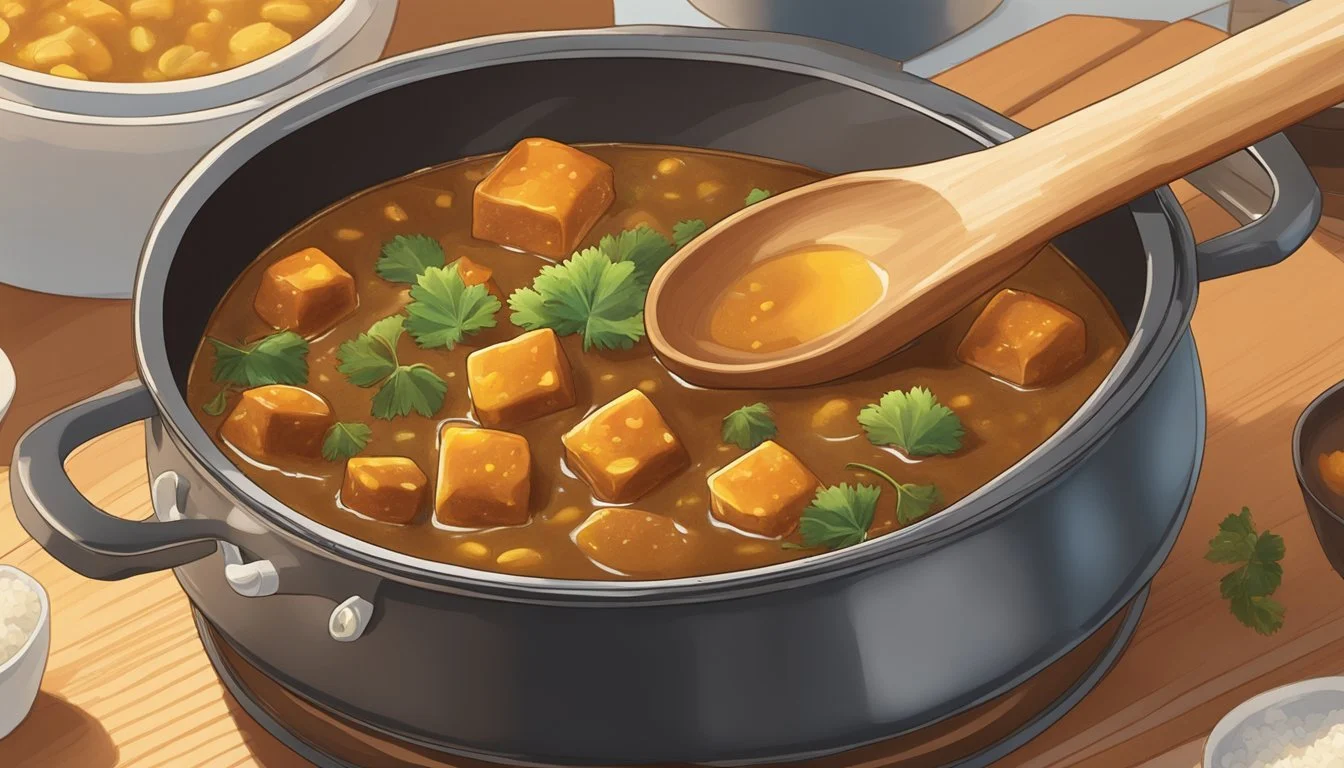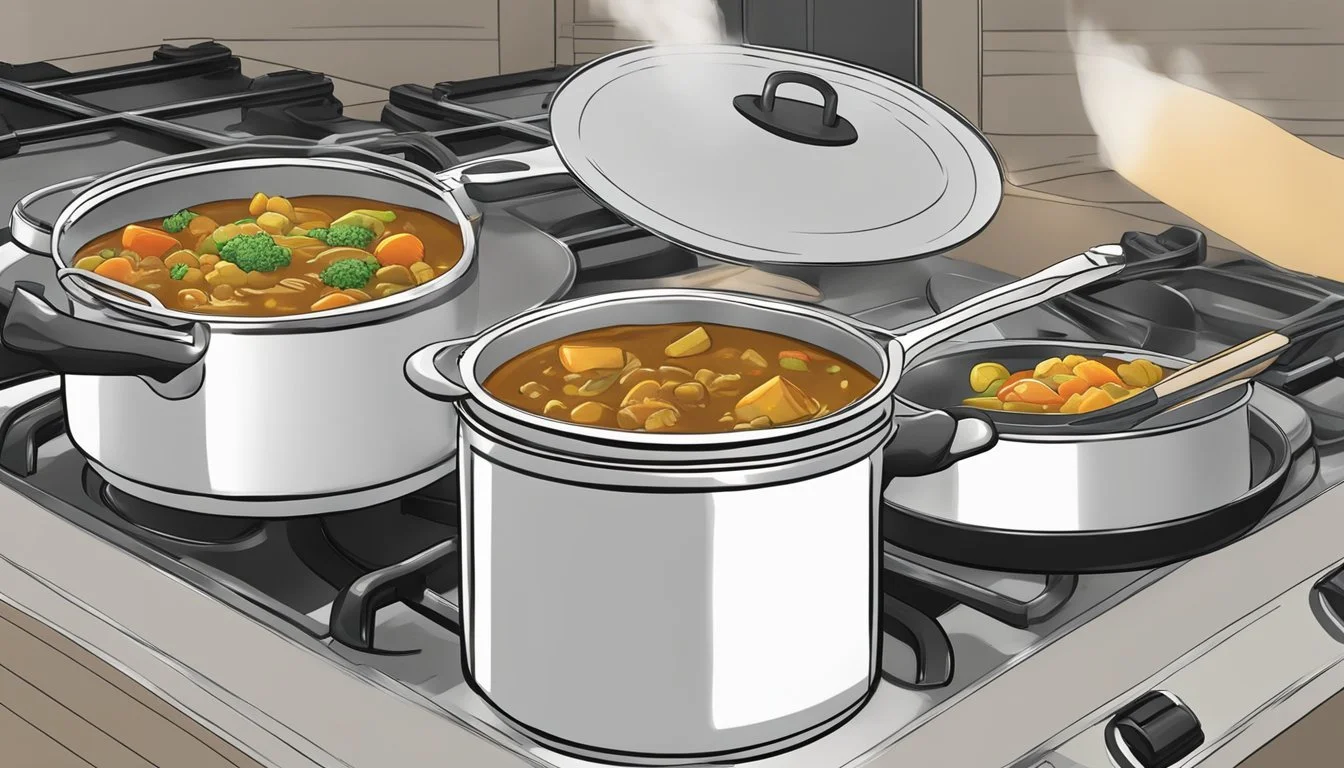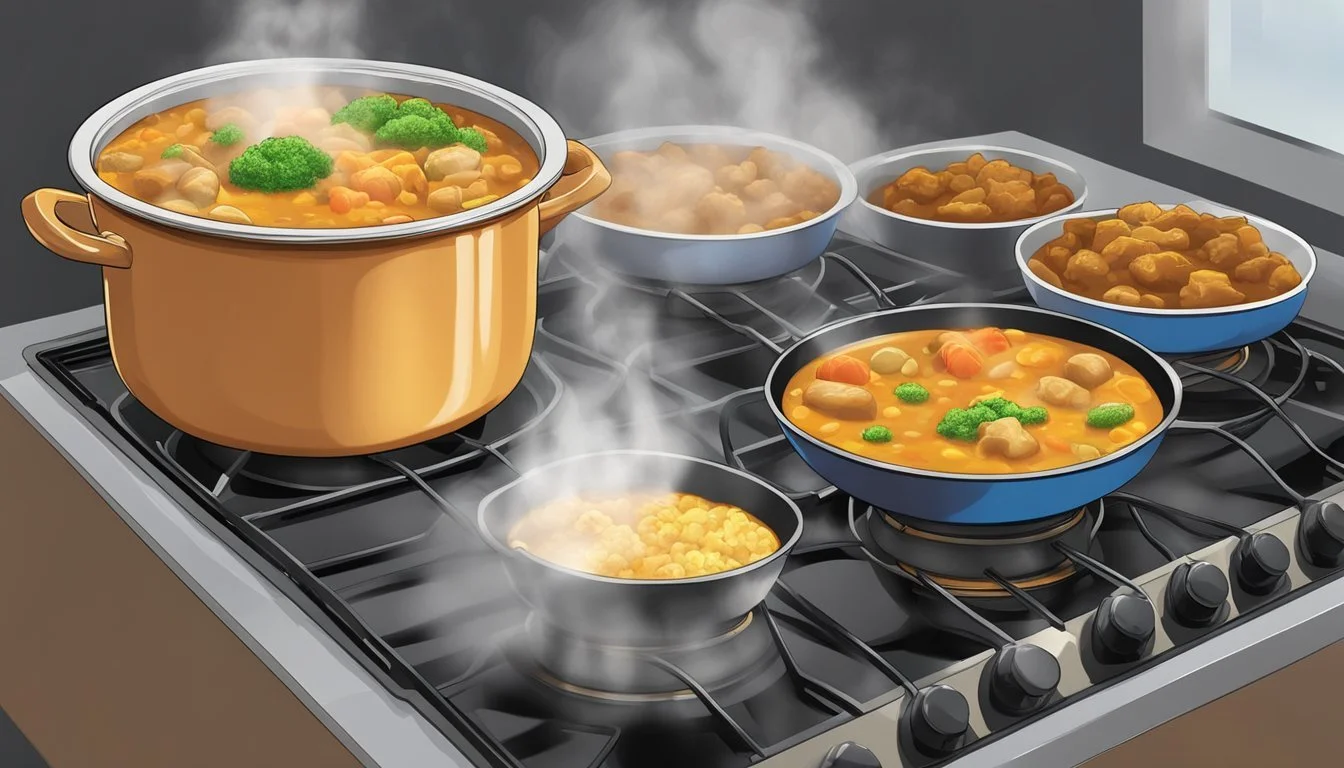Best Way to Reheat Japanese Curry Without Losing Flavor
Expert Tips for a Perfect Consistency
Japanese curry ranks as a staple comfort food known for its thick texture and savory flavor profile. It's an intricate mix of spices and ingredients that come together to create a rich taste that often improves with time. However, reheating this dish while preserving its distinctive thick consistency and deep flavors can be a challenge. Achieving the right temperature and method is crucial to ensure that the curry tastes as good as the moment it was first served.
When the goal is to reheat Japanese curry, attention to detail is paramount. Gently warming the curry on the stove or in the oven can help maintain its robust flavor and texture. It's important to avoid hurriedly blasting it with high heat, which can cause separation and loss of texture. Instead, steady and even heat encourages the flavors to meld together once again without jeopardizing the curry's signature thickness.
Careful addition of a little water or broth can also be beneficial if the curry has thickened too much when stored in the refrigerator. This slight dilution allows for a return to the desired consistency during reheating. Whether enjoying a homemade batch or savoring leftovers from a favorite restaurant, knowing how to properly reheat Japanese curry can greatly enhance the dining experience, making the dish nearly as delightful as when it first simmered on the stove.
Understanding Japanese Curry
Japanese curry's unique appeal lies in its rich flavor profile and thick consistency, a departure from its Indian counterpart. Here we explore the fundamental components that create this hearty dish.
Key Ingredients and Spices
Listed below are the essential ingredients and spices that contribute to Japanese curry's distinctive taste and texture:
Base Vegetables: Onions, carrots, and potatoes (often Yukon Gold or russet potatoes for their starchy quality)
Protein: Common variants include chicken, vegetarian options, or seafood curries
Umami Enhancers: Soy sauce and grated apple
Sweetness Enhancers: Ingredients such as honey and ketchup
Spices: Traditional Japanese curry powder, which includes turmeric and garam masala, comprising cinnamon, cloves, and cardamom, garlic, and ginger
Thickening Agents: A roux of flour and butter or a store-bought curry roux to maintain the sauce's thick consistency
Additional Flavorings: Salt, black pepper, and sometimes tomatoes
Culinary Techniques
Key techniques in preparing Japanese curry involve:
Layering Flavors: Spices such as garlic and ginger are sautéed to build the base flavor before adding other ingredients. The curry is then simmered to meld the flavors.
Thickening the Sauce: A roux is essential for the curry's viscous consistency. It is made by cooking equal parts flour and butter or by incorporating a pre-made curry roux.
Simmering: To develop a depth of flavor, the curry sauce and ingredients are usually left to simmer gently in a saucepan.
Reheating Leftovers: When reheating leftover curry, it is typically done slowly over medium heat, with occasional stirring to prevent burning and sticking, ensuring that the savory flavors and thick consistency are preserved.
Preparation Before Reheating
Proper preparation is key to successfully reheating Japanese curry without compromising its texture and flavor. Before proceeding to reheat, ensure that the curry had been stored correctly. If one has leftovers, they should transfer the curry to an airtight container immediately after the meal to ensure freshness. The optimal storage is in the fridge, where the curry can be kept at a safe temperature. Leftovers should be consumed within two to three days for best quality.
For frozen curry, it's imperative to allow it to thaw completely in the refrigerator before reheating. One should never attempt to reheat curry directly from its frozen state, as it may not reheat evenly, which risks affecting both taste and safety.
Here is a checklist to prepare Japanese curry for reheating:
Check consistency: If the curry appears too thick after storage, thin it out with a little water or stock.
Room temperature: Allow the curry to reach room temperature for even reheating, especially if it has been stored in the fridge.
Stir well: Mix the curry thoroughly before transferring it to the chosen reheating container to ensure uniform heat distribution.
Storage Type Preparation Before Reheating Fridge (Leftovers) Transfer to room temperature, check consistency, stir well. Freezer (Frozen Curry) Thaw completely in the fridge, then bring to room temperature.
By following these preparatory steps, one can ensure that their Japanese curry retains its rich and savory consistency, making it almost as good as when it was first prepared.
Reheating Methods
Reheating Japanese curry requires attention to detail in order to maintain its thick consistency and savory flavor. Here are the best approaches using different kitchen appliances to ensure even heat distribution and optimal internal temperature.
Stovetop Reheating
One may reheat curry on the stovetop by pouring it into a saucepan and adding approximately 2 to 3 tablespoons of water to help maintain moisture. The saucepan should be covered with a lid, and the curry heated on a low flame. Stirring occasionally is crucial to prevent sticking and to promote even reheating. This process typically takes about 4-5 minutes.
Oven Reheating
For oven reheating, one should preheat the oven to 350°F (180°C). The curry should be transferred to an oven-safe dish, with a little extra water or stock mixed in to thin out the sauce if it's too thick. Covering the dish with aluminum foil or a lid is important to prevent drying out. It's recommended to heat the curry for 15-20 minutes, stirring occasionally to ensure even heat distribution.
Microwave Reheating
The microwave offers a rapid reheating option. To reheat curry in the microwave, transfer it into a microwave-safe bowl. One might cover the bowl with a damp cloth or paper towel to retain moisture. The curry should be microwaved for 1-2 minutes, or until it reaches the desired temperature. Pausing to stir at least once during the process will assist with even reheating.
Reheating on the Stovetop
When one wishes to reheat leftover Japanese curry on the stovetop, maintaining the thick and savory consistency of the dish is paramount. The stovetop method is preferred for its superior heat distribution, which is critical in avoiding the separation of flavors and ensuring a moist outcome.
To start, one should opt for a heavy-bottomed saucepan or pot to allow for even heating. The curry should be placed into the pot and a moderate amount of stock or water added to it. This step is crucial as it prevents the curry from drying out and helps maintain its original consistency.
The curry should then be heated on a low to medium setting. It’s important to stir occasionally, which promotes uniform heating and prevents sticking or burning. One should not rush this process; a gentle simmer is the ideal condition under which the flavors have the opportunity to meld together again.
While the curry is slowly reheating, one can take advantage of this time to prepare steamed rice, as it is the perfect accompaniment to Japanese curry. If the rice is also a leftover, it can be reheated separately with a sprinkle of water and covered with a damp cloth in the microwave.
Once the curry begins to simmer, it is advisable to reduce the heat to a low setting. If the consistency seems too thick, additional stock or water can be incorporated in small increments. After a thorough heating, achieving at least a simmer for a few minutes, the Japanese curry should approach its original, savory state, ready to be savored once more.
Reheating in the Oven
When reheating Japanese curry in the oven, one should preheat the oven to 350°F (180°C) to ensure even heat distribution. They need to transfer the curry into an oven-safe dish, ideally ceramic or glass, to withstand the heat. It's recommended to add a small amount of water or stock to the curry to counteract any drying out and help maintain its savory consistency.
The oven-safe dish should then be covered with aluminum foil. The foil acts as a lid, trapping moisture and heat, preventing the curry from drying out and helping to warm it evenly. If the curry is spread thinly over a large surface area, like a baking sheet, it should be covered entirely with foil.
Curry should be placed on the middle rack of the oven. The gentle, all-around heat of the oven warms the curry slowly, which helps retain its thick consistency and robust flavor. The curry should be heated for about 15-20 minutes, but times may vary depending on the oven and the amount of curry.
During the reheating process, it's advisable to stir the curry occasionally to promote uniform temperature and prevent any curry at the edges of the dish from overcooking. Care should be taken when removing the aluminum foil post-reheat, as the steam released can be quite hot.
Ovens are a preferred method for larger portions, but for smaller amounts or when in a hurry, a microwave or slow cooker could be more convenient. However, using an oven is a sure way to maintain the taste and texture that might be lost with quicker methods.
Reheating in the Microwave
When reheating Japanese curry in the microwave, one should ensure that the curry is placed in a microwaveable container, which can be either glass or ceramic. Avoid containers that are unsafe for microwave use, such as some plastics that can melt or leach chemicals into food.
Instructions for Microwave Reheating:
Preparation: Transfer the Japanese curry into a microwave-safe dish.
Moisture: To avoid drying out the curry, one might need to add a tablespoon or two of water or broth.
Covering: Use a microwave-safe lid or plastic wrap to cover the dish. This will help to keep in the moisture and ensure even heating. If using plastic wrap, it should not touch the food; leave a small opening for steam to escape.
Setting: Set the microwave on a lower heat setting, which helps to warm the curry gently without overcooking it or causing it to splatter.
Timing: Heat initially for one minute, then stir the curry to help distribute the heat evenly.
Checking: Check the temperature of the curry. If it is not yet at the desired heat, continue to microwave in short 15-second intervals, stirring in between and checking the temperature each time.
Important Points:
Avoid High Heat: High heat can cause the curry to become too thin or alter the flavors negatively.
Stirring: It’s critical to stir periodically to ensure even reheating throughout the curry.
Temperature Check: Use a food thermometer to ensure the curry has reached a safe internal temperature.
By following these steps, the curry should retain its thick texture and savory consistency. For those with an Instant Pot, please note that this appliance is not typically used for reheating in a microwave capacity.
Tips to Maintain Quality
Reheating Japanese curry requires careful attention to preserve its thick consistency and savory flavors. Here are some techniques to maintain quality during the reheating process.
Avoiding Dryness
To prevent Japanese curry from becoming dry, adding a small amount of water can be beneficial. However, one should be cautious not to dilute the richness of the curry. It's important to heat the curry slowly and on low heat, using a lid to cover the pot, which helps to retain moisture. A glass lid is preferable as it allows one to observe the curry without removing the lid and releasing steam.
Stir Frequently: Agitating the curry periodically prevents it from sticking to the pan and ensures even heat distribution, avoiding dry spots.
Add Liquids Sparingly: If the curry is too thick, adding a splash of water, broth, or coconut milk can improve its moisture content without compromising flavor. Start with a minimal amount and increase as needed.
Preventing Flavor Loss
Flavor is paramount in Japanese curry, and reheating it should not compromise its complex taste profile. To maintain the integrity of the curry's flavors:
Use gentle heat: Reheat the curry on the stovetop over medium-low heat to prevent the loss of delicate flavors.
Avoid direct high heat: Microwaving can sometimes cause uneven heating and lead to flavor loss. If a microwave is used, one should do so at a reduced power setting and in short intervals, stirring in between.
Incorporate dairy last: If the recipe includes dairy products like cream or milk, these should be stirred in after the curry has been reheated to the desired temperature to prevent separation and flavor loss.
Prevent clumping: Continuously stir the curry while reheating to maintain a smooth consistency and prevent clumping of the roux if present.
By following these steps, one can effectively reheat Japanese curry and enjoy a dish that is both thick and replete with the savory flavors typical of this beloved meal.
Safety and Storage Considerations
When it comes to reheating Japanese curry, safety and preservation of its rich consistency are paramount. A consumer must ensure that the curry is stored correctly to mitigate the risk of bacteria growth which could lead to foodborne illnesses.
Storing in the Fridge: Japanese curry should be placed in the fridge within two hours of cooking. It's recommended to store it in an airtight container to maintain its savory quality and prevent contamination from other foods. The optimal refrigerator temperature should be at or below 40°F. Use a food thermometer to check.
Freezing Curry: If the curry is not going to be consumed within a few days, freezing is a great option to extend its shelf life. Store the curry in an airtight container or heavy-duty freezer bags. Label the container with the date of freezing. A freezer should maintain a temperature of 0°F or lower.
Thawing and Reheating: Always thaw frozen curry in the fridge, not at room temperature. Once thawed, reheat the curry to a minimum internal temperature of 165°F, as verified by a food thermometer. This is crucial to eliminate any potential bacteria.
Airtight Containers: Whether in the fridge or freezer, an airtight container is crucial to prevent moisture loss and protect the curry from absorbing flavors of other foods.
By strictly adhering to these safety and storage measures, one not only ensures the longevity of the Japanese curry but also its optimal texture and taste when reheated.
Serving Suggestions
When reheating Japanese curry to achieve a thick and savory consistency, serving it the right way can significantly enhance its flavor. A bed of piping hot steamed rice is a classic accompaniment, providing a neutral base that absorbs the rich taste of the curry. It's imperative that the rice retains its texture and warmth, as it complements the thick sauce of the curry.
Rice: White or brown, slightly undercooked during initial preparation ensures it won't become mushy when reheated along with the curry.
Protein: Whether it's chicken, beef, or tofu, make sure the protein in the curry is heated through but not overcooked to maintain its tenderness.
For those who prefer an alternative to rice, naan bread serves as a delightful vessel for scooping up the thick gravy. It's best when warmed slightly in the oven to stay soft and pliable.
Flavor Enhancers:
A squeeze of lemon juice can add a refreshing zest and heighten the flavors.
A sprinkle of fresh herbs or a small dollop of flavorful chutney can elevate the taste experience.
When serving a takeaway curry that's been reheated, make sure to achieve a balance between the temperature of the curry and the freshness of the sides. All components should complement each other, with the curry being hot enough to marry well with the rest of the dish without overshadowing the taste of the accompanying elements.








